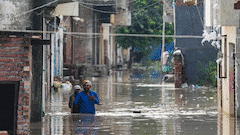Delhi Weather: National Capital Records 29 Degrees Celsius In First Week Of February, Hottest Since 2011
The national capital experienced the hottest day in two years on Monday, recording a maximum temperature of 29 degrees Celsius, six notches above normal.

Delhi continues to record above-normal temperatures. According to the Indian Meteorological Department (IMD), the minimum temperature early Tuesday morning settled at 12.8 degrees Celsius, four notches above normal in the national capital. The day will remain warm and sunny on Tuesday as well, according to IMD.
Meanwhile, the national capital experienced the hottest day in February in two years on Monday, recording a maximum temperature of 29 degrees Celsius, six notches above normal. Whereas the minimum temperature settled at 9.2 degrees Celsius, normal for this time of the year, according to the meteorological department.
Since 2011, this is the first time that Delhi recorded a day temperature of 29 degrees Celsius or above in the first week of February. Normally, the city logs an average maximum temperature of 23.2 degrees Celsius from February 6 to 9.
The city recorded a maximum temperature of 25.7 degrees Celsius, three notches above normal on Sunday. The relative humidity recorded at 8:30 am was 88 per cent, the IMD said.
According to PTI, on February 26, 2021, Delhi logged a maximum temperature of 33.2 degrees Celsius.
“February usually sees strong winds, which causes a slight fall in temperature. As strong surface winds at the speed of 20-30 kmph are predicted on a few days this week, the day temperature is likely to dip,” Kuldeep Srivastava, head of IMD’s regional weather forecasting centre, told Times of India.
He further stated, “Clear skies, change in wind direction to south-easterly and low wind speed have led to a rise in maximum temperature.”
Meanwhile, the city's 24-hour average air quality index (AQI) on Monday worsened to 265 from 244 on Sunday. As per PTI, strong surface winds on Tuesday are likely to improve the air quality.
An AQI between 201 and 300 is considered 'poor', 301 and 400 'very poor' and 401 and 500 'severe'.
The weather is unusually warm in Shimla as well. The hill station, which between December and March used to be draped in a blanket of snow mostly presents a brownish look with dry grass covering the hills. According to PTI, environmentalists and locals are concerned about the rising temperatures and depleting snow cover. Its effect now is more visible than ever in the hill city's dwindling winter tourist inflow and drying water sources.
Snow plays a vital role in replenishing the city's perennial sources of water such as springs, streams and rivulets. Scanty snowfall means the water sources dry up and the towns face scarcity.
In 2018, the problem of water shortage had risen to such alarming levels that the water supply had to be restricted to every fifth or sixth day, severely denting the inflow of tourists during the peak summer season, reported PTI.
As per meteorological department data, the snowfall from November to March in Shimla in 1989-90 was 556.7 cm while the figure stood at just 105.2 cm in the corresponding period of 2008-09.





































